What Happened to All the Supermassive Black Holes? Cosmologists Shocked by Webb Information
Dynamic Cosmic Core Idea

The James Webb Space Telescope (JWST, or Webb) is a circling infrared observatory that will supplement and broaden the revelations of the Hubble Space Telescope. It covers longer frequencies of light with extraordinarily further developed awareness, permitting it to see inside dust mists where stars and planetary frameworks are shaping today as well as looking further back so as to notice the primary worlds that shaped in the early universe.
A College of Kansas overview of an area of the universe utilizing the James Webb Space Telescope has uncovered dynamic cosmic cores—ssupermassive dark openings that are quickly expanding in size—that are more extraordinary than numerous cosmologists had expected beforehand.
The discoveries, made with the JWST's Mid-Infrared Instrument (MIRI), suggest our universe might be a smidgen more steady than was assumed. The work likewise gives bits of knowledge into perceptions of weak worlds, their properties, and difficulties in distinguishing AGN.
Another paper specifying the JWST research, led under the support of the Enormous Development Early Delivery Science (CEERS) program, was made accessible as of late on arXiv ahead of the formal friend survey distribution in The Astrophysical Diary.
The work, headed by Allison Kirkpatrick, partner teacher of physical science and cosmology at KU, zeroed in on a long-concentrated zone of the universe named the Drawn-Out Groth Strip, situated between the Ursa Major and Boötes heavenly bodies. Notwithstanding, past assessments of the area depended on a weaker age of room telescopes.
"Our perceptions were taken in June and December, and we were expecting to portray how systems looked during the prime of star arrangements known to man," Kirkpatrick said. "This is a look back in time from 7 to 10 billion years ago. We utilized the mid-infrared instrument on the James Webb Space Telescope to take a gander at dust in systems that existed 10 billion years ago, and that residue can conceal continuous star development and developing supermassive dark openings. So I completed the primary study to look for these hiding, supermassive dark openings at the focuses of these worlds."
Discoveries and Suggestions
While each system includes a supermassive dark opening at the center, AGN are more staggering disturbances, effectively attracting gases and showing a radiance missing from normal dark openings.
Kirkpatrick and numerous individual astrophysicists guessed that the higher-goal JWST overview would find a lot more AGN than a past study directed with the Spitzer Space Telescope. Notwithstanding, even with MIRI's lift in power and awareness, scarcely any extra AGN were tracked down in the new review.
"The outcomes appeared to be totally unique from what I had expected, prompting my most memorable and significant astonishment," Kirkpatrick said. "One huge disclosure was the shortage of quickly developing supermassive dark openings. This tracking down incited inquiries concerning the whereabouts of these items. It just so happens that these dark openings are reasonably developing at a slower speed than recently accepted, which is captivating, taking into account that the universes I analyzed look like our Smooth Way from an earlier time. Prior perceptions utilizing Spitzer just permitted us to concentrate on the most brilliant and most enormous systems with quickly developing supermassive dark openings, making them simple to identify."
Kirkpatrick said a significant secret in cosmology lies in figuring out how ordinary supermassive dark openings, for example, those found in worlds like the Smooth Way, develop and impact their host systems.
"The review's discoveries recommend that these dark openings are not developing quickly, retaining restricted material, and maybe not altogether influencing their host systems," she said. "This revelation opens up a totally different point of view on dark opening development since our ongoing comprehension is to a great extent founded on the most huge dark openings in the greatest systems, which essentially affect their hosts, yet the more modest dark openings in these universes probably don't."
Engineers worked carefully to embed the James Webb Space Telescope's Mid-Infrared Instrument into the ISIM, or Coordinated Science Instrument Module, in the cleanroom at NASA's Goddard Space Flight Center in Greenbelt, Md., on April 29, 2013. As the replacement for NASA's Hubble Space Telescope, the Webb Telescope will be the most remarkable space telescope ever fabricated. It will notice the most far-off objects known to man, give pictures of the primary worlds, and see neglected planets around far-off stars.
Another amazing result was the absence of residue in these systems, said the KU cosmologist.
"By utilizing JWST, we can distinguish a lot more modest universes than at any time in recent memory, including those the size of the Smooth Way or much more modest, which was beforehand unthinkable at these redshifts (grandiose distances)," Kirkpatrick said. "Regularly, the most huge universes have plentiful residue because of their quick star arrangement rates. I had accepted that lower-mass cosmic systems would likewise contain significant measures of residue; however, they didn't, opposing my assumptions and offering another charming disclosure."
As per Kirkpatrick, the work changes our comprehension of how systems develop, especially concerning the Smooth Way.
"Our dark opening appears to be very ordinary, not showing a lot of action," she said. "One huge inquiry in regards to the Smooth Way is whether it was ever dynamic or went through an AGN stage. If most systems, similar to our own, need noticeable AGN, it could suggest that our dark opening was rarely more dynamic before. Eventually, this information will help compel and gauge dark opening masses, revealing insight into the starting points of dark openings developing, which remain an unanswered inquiry."
Reference: "CEERS Key Paper VII: JWST/MIRI Uncovers a Weak Populace of Systems at Grandiose Early afternoon Inconspicuous by Spitzer" by Allison Kirkpatrick, Guang Yang, Aurelien Le Bail, Greg Troiani, Eric F. Ringer, Nikko J. Cleri, David Elbaz, Steven L. Finkelstein, Nimish P. Hathi, Michaela Hirschmann, Benne W. Holwerda, Dale D. Kocevski, Beam A. Lucas, Jed McKinney, Casey Papovich, Pablo G. Perez-Gonzalez, Alexander de la Vega, Micaela B. Bagley, Emanuele Daddi, Imprint Dickinson, Henry C. Ferguson, Adriano Fontana, Andrea Grazian, Norman A. Grogin, Pablo Arrabal Haro, Jeyhan S. Kartaltepe, Lisa J. Kewley, Anton M. Koekemoer, Jennifer M. Lotz, Laura Pentericci, Nor Pirzkal, Swara Ravindranath, Rachel S. Somerville, Jonathan R. Trump, Stephen M. Wilkins and L. Y. Aaron Yung, Presented, The
Kirkpatrick has as of late procured huge amounts of new time on JWST to complete a bigger study of the drawn-out Groth Strip field with MIRI. Her ongoing paper includes around 400 universes. Her forthcoming review (Super: MIRI EGS Cosmic System and AGN Overview) will incorporate around 5,000 worlds. The work is anticipated for January 2024.
About the Creator
Enjoyed the story? Support the Creator.
Subscribe for free to receive all their stories in your feed. You could also pledge your support or give them a one-off tip, letting them know you appreciate their work.





Comments
There are no comments for this story
Be the first to respond and start the conversation.